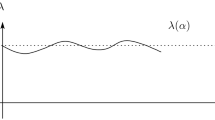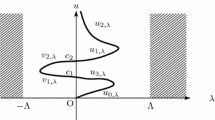Abstract
Solutions \(u \in H_0^1 (\Omega ) \cap H^2 (\Omega )\) of a semilinear elliptic boundary value problem, \(Au + f(x,u,\lambda ) = 0\) (with \(f_u (x,u,\lambda )\) bounded below) can be put into a one-to-one correspondence with zeros \(c \in \mathbb{R}^d \) of a function \(c \to B(c,\lambda ) \in \mathbb{R}^d \). Often d is small. The function \(B(c,\lambda )\) is called the bifurcation function. It can also be shown that the eigenvalues of the matrix \(B_c (c,\lambda )\) characterize the stability properties of the solutions of the elliptic problem as rest points of \(u_t + Au + f(x,u,\lambda ) = 0\). A finite element method that can be used for computing B and B c has recently been proposed. An overview of these results and the finite element method is given.
Similar content being viewed by others
References
L. Cesari, Functional analysis, nonlinear differential equations, and the alternative method, in: Nonlinear Functional Analysis and Differential Equations, eds. Cesari, Kannan and Schuur (Marcel Dekker, New York, 1976) pp. 1–197.
S.-N. Chow and J. K. Hale, Methods of Bifurcation Theory (Springer, New York, 1983).
P. Ciarlet, The Finite Element Method for Elliptic Problems (North-Holland, Amsterdam, 1978).
C. Foias and R. Temam, —Remarques sur les équations de Navier-Stokes stationnaires et les phénomènes successifs de bifurcation, Ann. Scuola Norm Sup.-Pisa 5(IV) (1978) 29–63.
D. Gilbarg and N. Trudinger, Elliptic Partial Differential Equations of Second Order (Springer, New York, 1983).
J. K. Hale, Asymptotic Behavior of Dissipative Systems (Amer. Math. Soc., Providence, RI, 1988).
D. Henry, Geometric Theory of Semilinear Parabolic Equations (Springer, New York, 1981).
M. Marion and R. Temam, Nonlinear Galerkin methods - the finite element case, Numer. Math. 57 (1990) 205–226.
M. Smiley, Global attractors and approximate inertial manifolds for nonautonomous dissipative equations, Applicable Analysis 50 (1993) 217–241.
M. Smiley, A finite element method for computing the bifurcation function for semilinear elliptic BVP's, J. Comp. Appl. Math. 70 (1996) 311–327.
M. Smiley, A global version of the principle of reduced stability, Preprint to appear.
G. Strang and G. Fix, An Analysis of the Finite Element Method (Prentice-Hall, Englewood Cliffs, NJ, 1973).
R. Temam, Infinite-Dimensional Dynamical Systems in Mechanics and Physics (Springer, New York, 1988).
E. Titi, On approximate inertial manifolds to the Navier-Stokes equations, J. Math. Anal. Appl. 149 (1990) 540–557.
Author information
Authors and Affiliations
Rights and permissions
About this article
Cite this article
Smiley, M.W. Numerical bifurcation and stability analysis for steady-states of reaction diffusion equations. Numerical Algorithms 14, 211–225 (1997). https://doi.org/10.1023/A:1019117130906
Issue Date:
DOI: https://doi.org/10.1023/A:1019117130906




